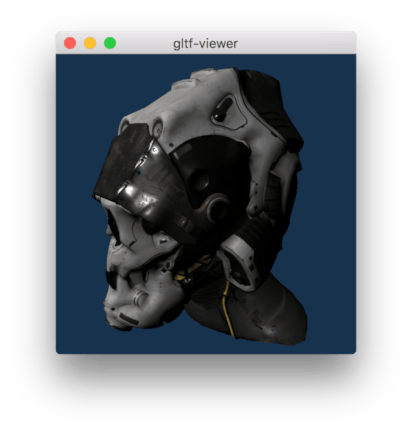4 releases
| 0.4.5-alpha.0 | Sep 5, 2024 |
|---|---|
| 0.4.4-alpha.0 | Sep 4, 2024 |
| 0.4.3-alpha.0 | Sep 4, 2024 |
| 0.4.2-alpha.0 | Sep 4, 2024 |
#49 in Rendering
125KB
2.5K
SLoC
Version of the crate available as library
gltf-viewer 
Rust glTF 2.0 viewer, written using the gltf crate and plain OpenGL.
Current state: All official sample models can be loaded and are rendered with the reference PBR shader. Example:

Gallery with all sample models: https://bwasty.github.io/gltf-viewer/0.3.0/
Some glTF features are not yet implemented, most notably animations. See #3 for details.
Installation
Binaries (Win/Linux/macOS)
See Latest Release
From crate (requires Rust)
cargo install gltf-viewer
Latest version (unstable):
cargo install --git https://github.com/bwasty/gltf-viewer.git
Usage
USAGE:
gltf-viewer [OPTIONS] <FILE>
OPTIONS:
-v, --verbose Enable verbose logging (log level INFO). Can be repeated up to 3 times to increase
log level to DEBUG/TRACE)
-s, --screenshot <FILE> Create screenshot (PNG)
-w, --width <WIDTH> Width in pixels [default: 800]
-h, --height <HEIGHT> Height in pixels [default: 600]
-c, --count <COUNT> Saves N screenshots of size WxH, rotating evenly spaced around the object [default:
1]
--headless Use real headless rendering for screenshots (default is a hidden window)
[EXPERIMENTAL - see README for details]
--straight Position camera in front of model if using default camera (i.e. glTF doesn't
contain a camera or `--cam-index -1` is passed).
--scene <scene> Index of the scene to load [default: 0]
--cam-index <CAM-INDEX> Use the glTF camera with the given index (starting at 0).
Fallback if there is none: determine 'nice' camera position based on the scene's
bounding box. Can be forced by passing -1.
Note: All other camera options are ignored if this one is given. [default: 0]
--cam-pos <CAM-POS> Camera (aka eye) position override as comma-separated Vector3. Example: 1.2,3.4,5.6
--cam-target <CAM-TARGET> Camera target (aka center) override as comma-separated Vector3. Example:
1.2,3.4,5.6
--cam-fovy <CAM-FOVY> Vertical field of view ('zoom') in degrees. [default: 75]
--help Prints help information
-V, --version Prints version information
ARGS:
<FILE> glTF file name
Both .gltf and .glb files are supported. Navigate the scene with the mouse: Rotate with left click + drag, pan with right click + drag, zoom with mouse wheel.
Example
$ curl -O https://raw.githubusercontent.com/KhronosGroup/glTF-Sample-Models/master/2.0/Box/glTF-Binary/Box.glb
$ gltf-viewer Box.glb
Headless screenshot generation
Proper headless screenshot generation with the --headless flag currently only works on macOS.
To work around that, a Docker setup that uses xvfb is provided. Usage examples:
# Build docker image and run it with the gltf mounted in a volume.
# The image will be saved next to the gltf file.
./screenshot_docker.sh Box.glb
./screenshot_docker.sh ../models/Box.gltf -w 1920 -h 1080 --count 3 -vv
# Use pre-built docker image from Docker Hub
DOCKER_IMAGE=bwasty/gltf-viewer ./screenshot_docker.sh Box.glb
Alternatively, you can also install xvfb and use ./run_xvfb.sh directly (Linux only).
Dependencies
~15MB
~260K SLoC
